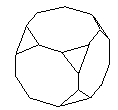The dual of the truncated octahedron has 24 triangular faces which careful consideration shows to come together to form 12 rhomboidal faces and so the dual is the rhombic dodecahedron.
The truncated octahedron and and the rhombic dodecahedron are particularly important because copies of them can be used to fill up R3 without any gaps. Consequently, they appear "in nature" as crystals of various chemical compounds. With the obvious exception of the cube, none of the other Platonic solids can do this.
 The stella octangula has 24 faces, 8 vertices with 3 incident edges and 6 vertices with 8 incident edges. Hence its dual solid has 24 vertices, 8 triangular faces and 6 octagonal faces. It is a truncated cube:
The stella octangula has 24 faces, 8 vertices with 3 incident edges and 6 vertices with 8 incident edges. Hence its dual solid has 24 vertices, 8 triangular faces and 6 octagonal faces. It is a truncated cube:Hence the symmetry groups of the stella octangular are the same as those of the cube/octahedron.
Sd ≅ S4 and S ≅ S4 × < J > .
Colouring the two tetrahedra differently reduces the symmetry groups to those of the tetrahedron: Sd ≅ A4 and S ≅ S4.
Colouring the top and bottom of the dual truncated cube differently from the others will give a figure whose rotational symmetry group Sd ≅ D4 (the rotational symmetries of the square half-way up) and whose full symmetry group is S ≅ D4 × < J > .
Colouring the upper and lower faces or edges of the stellar octangula will have the same effect.
The direct symmetries of F1 are the rotational symmetries of the "mid-rhombus" and hence the group Sd(F1) ≅ D2 .
Since J is a symmetry of F1 the full symmetry group S(F1) ≅ D2 × < J > .
Any rotational symmetry of F2 must be a rotational symmetry of the horizontal square and the only possible ones are rotation by π about a vertical axis through the centre or rotation by π about either of the diagonals.
Hence Sd(F2) ≅ D2 .
Since J is not a symmetry of F2 but F2 does have some opposite symmetries, the full symmetry group is a mixed group and hence we have S(F2) ≅ D4D2 .
If n is even, then Pn is centrally symmetric (and has x ↦ -x as a symmetry) and so the full symmetry group is Dn × < J > . If n is odd, then, as in the last question, the full symmetry group is the mixed group D2nDn .
The rotational group of the square antiprism consists of 4 rotations about the line joining the centres of the squares (including the identity!) and 4 rotations by π about lines joining the centres of opposite triangles.
The group Sd ≅ D4 .
(If you cut the antiprism by a plane halfway up you get a regular octagon and some of the symmetries of this are symmetries of the solid.)
The square antiprism is not centrally symmetric and so its full symmetry group is a mixed group which must be D8D4 .